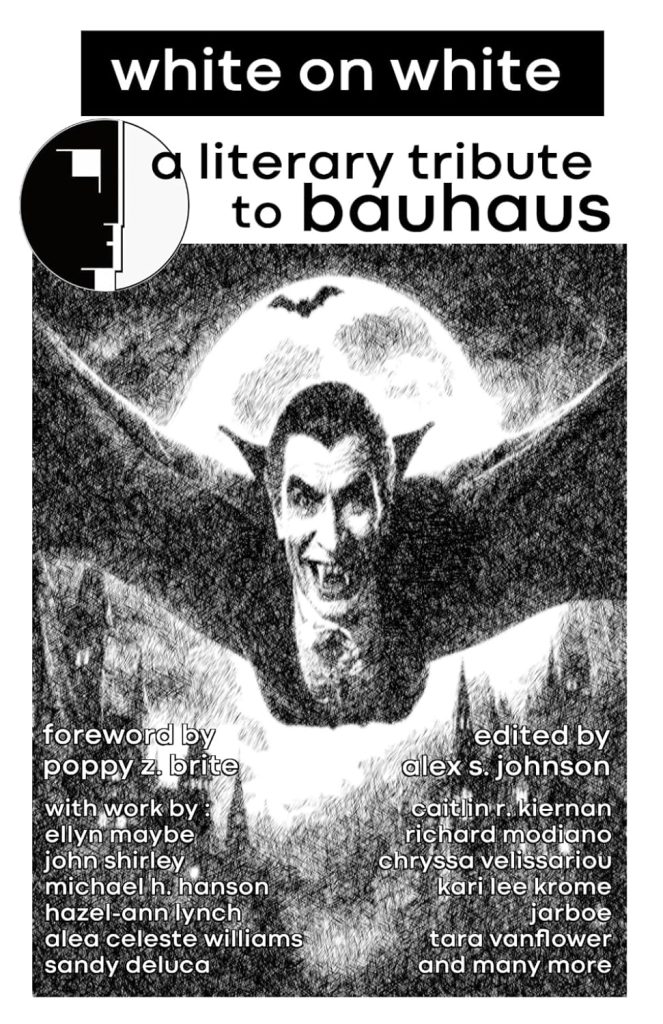
With the 1979 album “Bela Lugosi’s Dead,” British rock band Bauhaus thrust themselves firmly into the goth-rock scene. The anthology “White on White,” edited by horror writer Alex S. Johnson and released nearly 50 years after Bauhaus came together, pays homage to the spirit of the band and the broader Gothic sensibility.
“White on White” contains a mixture of poetry and prose in various styles and genres. Writers from different national backgrounds and literary traditions, including several whose work has been translated into English, contribute to a mashup of different sensibilities. Some poetry addresses the experience of listening to Bauhaus and plays off of song titles, others are more impressionistic takes on the band’s themes and aesthetic.
Common threads include shaky and fluid personal identity. In one piece, just the touch of pills on the ground obliterates and transforms a character and his dog, a young woman loses herself in her romantic obsession with a strange pale man and his diary, a man steals another’s train ticket and finds the other man’s face staring back at him through a mirror. Many characters live on the margins of their world, people who wouldn’t normally serve as main protagonists. One narrator is a groundskeeper on a historical estate of immortals, another is a lovelorn woman in her forties seeking oblivion and companionship in goth clubs, yet another has her last wishes disrespected on the day of her funeral.
The anthology probes power dynamics and the corruption that can come with extreme power imbalances. In one story, a woman with a gift for healing helps many, then carries out destruction after becoming world famous. In another, a clever grad student turns a spelunking expedition into spooky revenge on a professor who has exploited and discarded a string of women. The uncanny and supernatural sometimes become means for achieving justice, other realms where those who have been excluded or wronged can defend themselves. We see a murdered woman’s son, reincarnated through biotechnology, poetically avenging his mother, and a murderer whose goth-girl love interest sets him up to be arrested. One man seeks to destroy his own kind after realizing that he is something much scarier than the drug dealers and criminals who surround him, hoping to eliminate the threat he poses to innocent humans.
“White on White” takes place in a variety of settings. Inspired by Bauhaus’ music and the 1939 Dracula actor Bela Lugosi, we see a selection of tales within goth clubs and old buildings at night where vampires tend to lurk. Other pieces, though, are set within a biotech future where guitars and bedrooms come alive, in urban settings such as Little Italy, within caves rumored to hold Indiana Jones-style ancient relics, and an ordinary apartment building where a young female academic befriends an elderly gentleman with an active mind and tenuous grasp on reality.
These pieces blur the boundaries between the past and the present. People’s pasts catch up to them, people forget and remember who they truly are. History, memory, and decay show up as continual motifs: there’s a whole town of empty, dilapidated buildings, a dis-used broadcast tower in the midst of a shiny new city, and a radio station where a late night DJ plays Bauhaus and encounters the ghost of a guest murdered long ago in that room.
We see the interplay of past and present most clearly in a story near the end of “White on White,” where an aging actor dreams up the final performance of his career in a theater that’s now unused and decrepit. From his chair in his senior care home, this experience allows him to look back over his entire life and find meaning in all of his memories. He achieves his lifelong dream of acting where he saw his first old silent movie with his parents.
The Goth aesthetic is often linked with death in people’s minds, but this story is a celebration of life, all the more poignant by the protagonist’s acknowledging his mortality. This entire anthology embraces the grotesque, the marginal, the deathly, the traumatic, and the just plain weird with openness and curiosity. By doing this, the writers and curator point to an expansive world where there’s room for all sorts of people and where we can look beyond our fears and our pasts to fully welcome ourselves and each other.
White on White: A Literary Tribute to Bauhaus is available at your local bookstore through Bookshop.org.
It includes original pieces by such rock stars as Kari Lee Krome (The Runaways), Athan Maroulis (Spahn Ranch), Tara Vanflower (Lycia, Type O Negative), pieces by Bram Stoker Award-winning authors John Palisano and John Shirley (who also wrote The Crow screenplay and songs for Blue Oyster Cult), former Swans co-leader Jarboe, Caitlin R. Kiernan (two-time World Fantasy and Bram Stoker Award-winning author, Nebula award finalist), with a foreword by Poppy Z. Brite, the iconic author of Exquisite Corpse, and much more. The anthology is endorsed by David J. Haskins, the founding member of Bauhaus and Love and Rockets and writer of the song “Bela Lugosi’s Dead”; Haskins is also a Nocturnicon Books contributing author.
